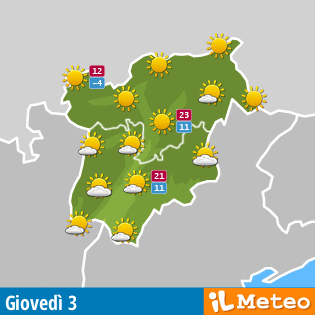Northern Dolomites
The largest Unesco area
 |
| Italian |

The Northern Dolomites are the largest area of all nine UNESCO sites, lies between the provinces of Belluno and Bolzano on a surface of 55.586 hectares. The area extends from Val Pusteria, Val di Sesto, Valley of San Cassiano and Val Badia in Bolzano province, to the valleys of the Piave and the Boite in Belluno province. The peaks forming the wall of World Heritage have well-known names: including the Dolomites of Sesto, the Tofane, the area of Cadini, groups of Braies, Fanes and Senes, Monte Cristallo and the Cadore Dolomites.
The Sesto Dolomites and the group of Cadini are in the north west of the Northern Dolomites. This area is characterized by spectacular high mountains, sometimes rising to the peaks of the Highlands, also of 2.000 meters. One of the most famous examples are the Tre Cime Di Lavaredo (Three Peaks), which with the Cima Grande touches 2.999 meters. Other known peaks are Cima Dodici to 3.094 meters, 3.092 meters high Cima Undici, Punta Tre Scarperi of 3.152 meters and the Croda dei Toni at 3.094 meters high. Further south, in Cortina d'Ampezzo territory is located Monte Cristallo. Its height of 3.221 meters allows the visitor to enjoy a breathtaking view on a variety of tops, as all the peaks of this area. The Cristallo has a subgroup called Pomagagnon that extends to the Mount Popena, 3.152 meters high. But other peaks overlooking the "Pearl of the Dolomites" and are part of the Northern Dolomites site. Tofane are spectacular peaks which rise as the Tofana of Rozes of 3.225 meters, the Middle Tofana of 3.244 meters of altitude and Tofana de Inze of 3.283 meters high. There is also the crest of Lagazuoi, known during the First World War because they traveled by numerous tunnels dug in order to surprise the enemy. Nearby is the Croda Rossa d'Ampezzo in 3.146 meters and Mount Cavallo, 2.912 meters high.
Always part of the Northern Dolomites but moved to the southwest, rises, beyond the Falzarego, the Group of Sett Sass (Seven Rocks). Peak of the same name is called cliffs Richthofen, in honor of a great Austrian geologist. The area to the south east of this complex is characterized by three massifs, which are part of the Cadore Dolomites: Sorapis of 3.205 meters high, the very extensive and mount Marmarole and mount Antelao. Latter is high 3.264 meters, second in height only to the Marmolada, it must be said however that is not included within the UNESCO sites.
Some more informations about Northern Dolomites
Of great importance is the fact that there is certainly right in this area there is the watershed between the basin of the Adriatic Sea with the Black Sea. Near Dobbiaco river Drava springs. This flows into the Danube and then descends to the Black Sea. The Sesto Dolomites, which in this area stand out, are part of the Natural Park of Sesto Dolomites. Are characterized by a rock from the very light color and include peaks known as the Paterno, even if only part of the famous Three Peaks, all the Rondoi-Baranci and the Group of Tre Scarperi. It was in the adjacent Fischleintal that collapsed in 2007, but without causing casualties, the Cima Una. This event made some fear for the fate of these magnificent mountains. Also in this area to the west, lies a vast district which falls within the confines of the Natural Park of Fanes-Senes-Braies Dolomites, also known as Dolomiti di Braies. Mountains are spectacular with walls that give to the Val Badia, Val di Marebbe and Val di San Cassiano, then continuing with Conturines. Characteristic of these places is the altar of Braies overlooking its namesake lake, which includes the Alpe di Senes and the Alpe di Fanes. These areas constitute an amphitheater formed by steps. From this particular and romantic landscape legends are born like that on the kingdom of Fanes and the alliance princesses Dolasilla and Lujanta with marmots.
The Northern Dolomites are, from the standpoint of geology, the most complete stratigraphic series of the Dolomites. The metamorphic basement of the ancient Cambrian continues in a series of layers of different geological eras to the most recent Oligo-Miocene. Many are even fossils, including large shells, dinosaur footprints and casts of extinct plants from millions of years.
